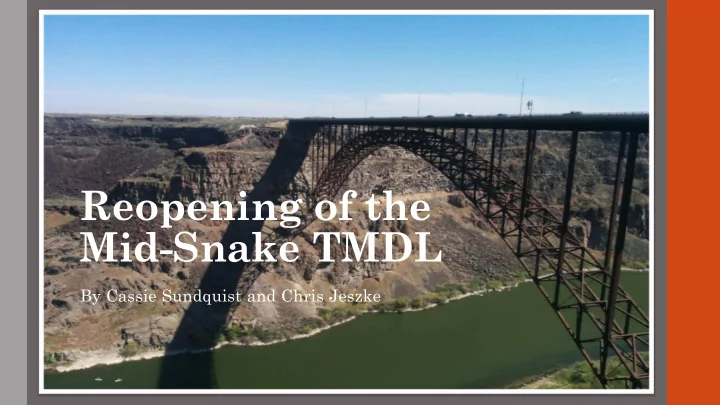

Reopening of the Mid-Snake TMDL By Cassie Sundquist and Chris Jeszke
Mid Snake TMDL • EPA approved the Mid Snake Phosphorus TMDL in 1997, representing Idaho’s first nutrient TMDL of consequence that involved point sources. • The premise for development of the 1997 Mid Snake TMDL was growth of nuisance aquatic plants (e.g., algal mats and macrophytes), which were obstructing the Middle Snake River.
Mid Snake TMDL • Milner Dam to King Hill • 93 river miles long
In Stream Targets • TMDL was finalized with two in-stream targets: (1) a TP in-stream target of 0.075 mg/L (2) a 30 percent reduction of nuisance aquatic plant growths in the Crystal Springs Reach. These targets are interrelated in that a reduction of TP will result in a reduction in macrophytes.
Five Year Review in 2010 • Middle Snake River was compliant for TSS and E. coli, but the TP targets had not been achieved in the main stem and multiple tributaries from 2000 to 2018. • Flows had been reduced, suggesting that the ability of the TMDL to support beneficial uses should be reevaluated. Possible causes of reduced flows are water withdrawals, drought, and climatic patterns.
“The Meeting” -April 2017 • EPA called a meeting with the DEQ Watershed Advisory Group in April 2017. Reduce backlog of permits before handing over primacy to DEQ. Discussed “strategy” for how they will issue permits. Can not make changes under the current administratively extended permits. EPA wants to update permit language and include monitoring, E-reporting and individual permit conditions. • EPA gave DEQ an ultimatum-reopen the TMDL and address nutrient impairment OR they will enforce 0.075 mg/L gross end of pipe limits on everyone. Estimated to put 70% of commercial hatcheries out of business and cost the City of Twin Falls approximately $100 million to come into compliance with a 99% reduction in Total P. • Lawyers and lobbyists are now attending all WAG meetings.
WAG Recommended to DEQ to Reopen the TMDL • Goals for revision Continue target of 0.075 mg/L to achieve 30% reduction in nuisance aquatic plant life. No one is denying water quality is poor but not one can agree on how to fix it…. PROBLEM #1 Incoming levels at Milner Dam are 0.080 mg/L. PROBLEM #2 No way to measure nuisance aquatic plant growth levels. PROBLEM #3 DEQ does not have jurisdiction to enforce waste load allocations on non-point sources i.e. confined feeding operations, grazing.
How will this affect the hatcheries? • Discharge limits for Total P will likely be lowered. Currently on section 3 of the TMDL revision. Section 5 is where allocations will be divvied out. (July-December 2018). Will receive a compliance schedule with new permits. • Results of this revision will likely have an effect on other TMDL’s throughout the state. Already gearing up to review the Lake Walcott TMDL.
Questions
Recommend
More recommend